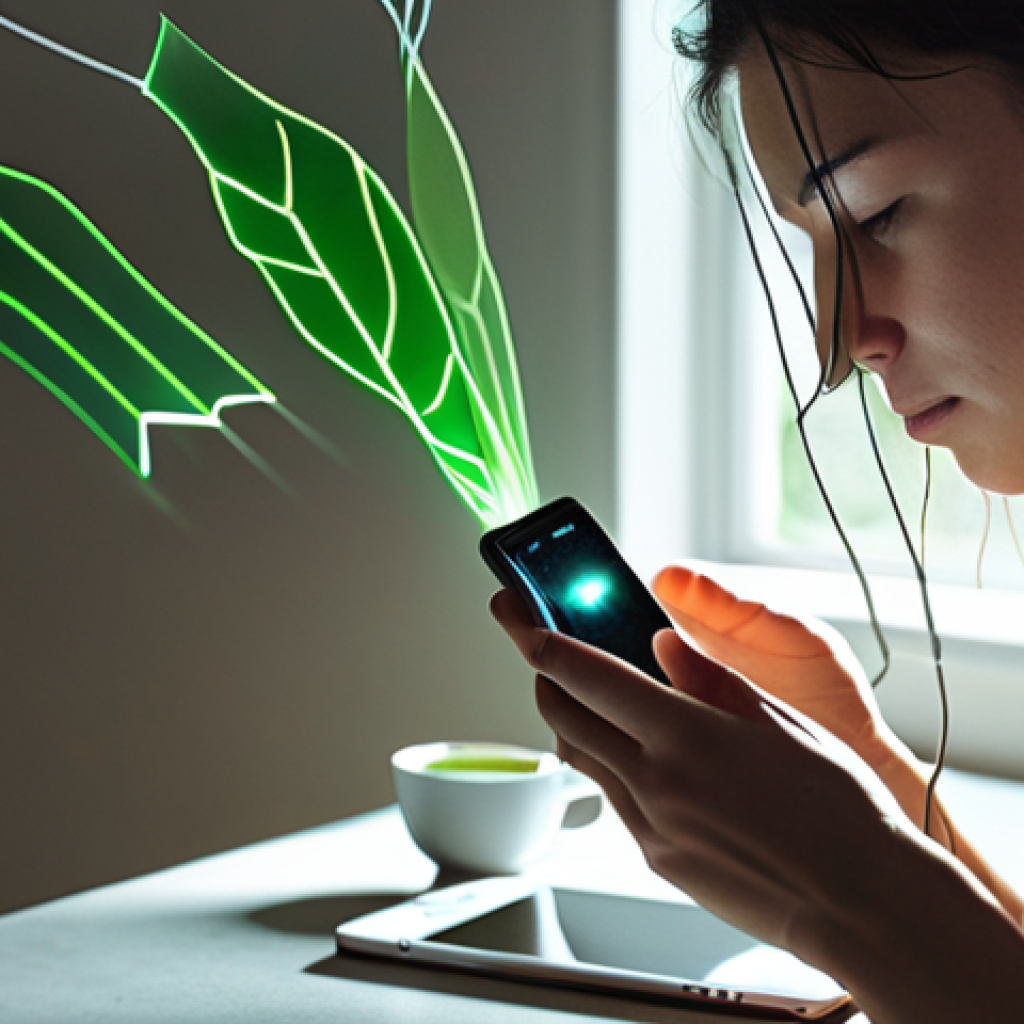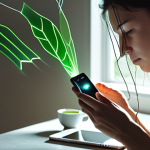In an age where our screens feel less like tools and more like extensions of our very being, it’s easy to get swept away by the constant deluge of notifications and endless scrolls.
Honestly, I’ve caught myself countless times staring blankly at my phone, wondering where the last hour went, feeling utterly drained rather than refreshed.
This pervasive digital tethering has sparked a vital conversation: the urgent need for digital detox and comprehensive digital well-being. We’re witnessing a palpable shift, a collective sigh of relief as more people embrace intentional breaks from the digital world, recognizing the profound impact constant connectivity has on our mental health, focus, and real-world relationships.
This isn’t just a trend; it’s a growing movement, reflecting a deeper societal awakening to the hidden costs of our hyper-connected lives. Beyond simply unplugging, the future of digital well-being looks towards smart tech that actively supports our balance, perhaps through AI-driven insights that gently guide healthier habits, or even ethical design principles that prioritize human well-being over endless engagement.
The conversation is evolving from just “how much screen time?” to “how can technology genuinely enhance, rather than detract from, our lives?” It’s a fascinating paradox to consider how the very devices designed to connect us can sometimes leave us feeling profoundly disconnected from ourselves.
Let’s delve deeper into this below.
Reclaiming Lost Moments: The Personal Odyssey to Disconnect

Honestly, for the longest time, I felt like my phone was less a tool and more an extension of my nervous system. Every ping, every notification, pulled me back into its gravitational field, and I’d find myself scrolling mindlessly, hours vanishing into the digital ether.
It wasn’t until I truly committed to my first serious digital detox that I realized the profound impact this constant tethering had on my mental clarity and overall sense of peace.
That first week, it felt like an arm was missing, a strange phantom limb sensation, but slowly, a quiet calm began to settle. I started noticing things again – the way the light fell through the window in the afternoon, the sound of birds outside, the simple joy of an uninterrupted conversation.
It’s a journey, not a destination, but one that has truly transformed how I interact with the world and myself. My personal experience has shown me that giving yourself permission to disconnect is one of the most powerful acts of self-care you can undertake in this hyper-connected world.
It’s about consciously choosing to be present, to engage with the immediate reality around you, rather than constantly being pulled into a virtual one.
This practice isn’t about shunning technology entirely, but rather about regaining control and creating a healthier, more intentional relationship with our devices.
1. The Subtle Chains: Unmasking Our Digital Habits
Before you can truly detox, you have to acknowledge the subtle ways technology has woven itself into your daily life. I remember a period where checking my phone was the first thing I did in the morning and the last thing at night.
My screen time reports were frankly alarming, showing hours lost to social media feeds and endless news cycles. It wasn’t about work; it was pure habit, an unconscious reflex.
This pervasive checking became a constant background hum in my life, dulling my senses and diminishing my ability to focus on complex tasks or even just relax.
We often don’t realize how deeply ingrained these patterns are until we try to break them. For me, it started with tracking my usage, not to judge, but to simply observe.
Seeing the raw data was a startling wake-up call, showing just how much of my precious time and attention was being siphoned off without my conscious consent.
It’s like realizing you’ve been walking around with a low-grade fever for years – you don’t know what truly feeling well is like until that fever breaks.
2. The Unplugging Paradox: Finding Connection Through Disconnection
This might sound counterintuitive, but for me, disconnecting from the digital world actually deepened my connections in the real one. When I wasn’t glued to my phone, I was more present with friends and family.
Conversations felt richer, laughs were louder, and I found myself truly listening, not just waiting for my turn to speak or mentally drafting a social media post.
I discovered the joy of spontaneous plans, of getting lost in a good book, or simply sitting in silence. My relationships thrived because I was giving them my full, undivided attention, something I now realize is the most valuable currency in human interaction.
It’s not about being anti-technology; it’s about being pro-humanity, and recognizing that our most profound experiences often happen offline, face-to-face, heart-to-heart.
The irony is that by stepping away from the “connected” world, I felt more genuinely connected than ever before.
Beyond the Scroll: Redefining Engagement in a Digital Age
The constant influx of information and the pervasive pressure to “be online” can leave us feeling overwhelmed and strangely unfulfilled. It’s a bit like trying to drink from a firehose – you get soaked, but you don’t actually quench your thirst.
I’ve found that the sheer volume of digital content often detracts from its quality and our ability to truly engage with it. For me, redefining engagement meant shifting from passive consumption to active, intentional interaction.
It’s about curating my digital diet, choosing what I consume with purpose, and ensuring that my online interactions are meaningful and enriching, rather than just fleeting distractions.
This shift in mindset has been profound, transforming my relationship with technology from one of being a passive recipient to an active participant, carefully selecting what truly serves me and my well-being.
It’s about valuing depth over breadth, substance over superficiality, and genuine connection over fleeting likes.
1. From Mindless Scrolling to Mindful Consumption
One of my biggest revelations was realizing how much of my screen time was purely passive, driven by habit rather than genuine interest. Those endless scrolls through social media feeds, the auto-playing videos, the constant refreshing for something new – it was all draining my energy without offering any real value.
I started asking myself, “Is this adding to my life, or just taking away my time?” This simple question became my filter. I began curating my feeds, unfollowing accounts that didn’t inspire or inform me, and seeking out content that genuinely sparked my curiosity or offered valuable insights.
It’s like cleaning out a cluttered closet; suddenly, you have space for things that truly matter. This mindful approach to consumption has made my digital interactions far more enriching and less like a time sink.
I’m no longer just scrolling; I’m seeking, learning, and engaging with purpose.
2. Cultivating Digital Boundaries: Your Personal Firewall
Setting boundaries isn’t just for our in-person relationships; it’s absolutely crucial for our digital ones too. For me, this meant implementing strict “no phone” zones in my home – no phones at the dinner table, no phones in the bedroom before a certain time, and certainly no phones during family activities.
It also involved setting app limits and turning off non-essential notifications. Initially, it felt restrictive, almost like a cage, but very quickly it became liberating.
These boundaries created mental space, allowing me to fully immerse myself in real-world experiences without the constant tug of digital distraction. It’s about creating a personal firewall that protects your attention and sanity from the incessant demands of the digital world.
This isn’t about being anti-social or disconnected; it’s about being intentional about when and how you engage, ensuring that technology serves you, rather than the other way around.
The Silent Toll: How Constant Connectivity Shapes Our Minds
It’s easy to dismiss the subtle impacts of constant connectivity, but trust me, they’re there, quietly eroding our focus, patience, and even our emotional well-being.
I distinctly remember feeling a perpetual sense of low-grade anxiety, a constant hum of expectation that I should be responding, engaging, or just *doing* something online.
My concentration span seemed to shrink, making it harder to read a book, watch a long movie, or even hold a deep conversation without my mind wandering.
The sheer volume of information, coupled with the always-on pressure, created a mental fog that I hadn’t even realized was there until it started to lift.
It’s a silent, insidious kind of pressure that can subtly change how our brains function, from our ability to focus to our capacity for deep thought and genuine empathy.
We’re constantly stimulated, yet rarely deeply engaged, leading to a strange paradox of hyper-awareness and profound mental exhaustion.
1. The Erosion of Attention: Battling Digital Distraction
Our brains are simply not wired for the constant barrage of information and immediate gratification that the digital world provides. I noticed my own attention span dwindling rapidly.
Trying to focus on a single task, even something I enjoyed, felt like an uphill battle against an invisible current pulling me towards my phone. Every notification, every new email, every trending topic felt like an urgent call to attention.
This constant switching, known as “context switching,” is incredibly taxing on the brain and prevents us from engaging in deep work or sustained contemplation.
It’s like trying to juggle twenty balls at once; you might keep them all in the air for a moment, but you’re not doing any one thing well, and eventually, you drop them all.
Reclaiming that sustained attention requires deliberate effort to create environments free from digital interruptions.
2. Navigating the Digital Emotional Rollercoaster
Social media, in particular, can be an absolute emotional rollercoaster. One moment you’re enjoying a friend’s post, the next you’re spiraling into comparisonitis, feeling inadequate or left out based on carefully curated highlight reels.
I’ve been there, staring at perfectly filtered lives, wondering why mine didn’t measure up. This constant exposure to idealized versions of reality, coupled with the pressure to present a flawless version of ourselves, can be incredibly detrimental to self-esteem and lead to increased feelings of loneliness or anxiety.
It’s a tricky game our minds play, where what we see online often distorts our perception of our own lives, making us feel perpetually behind or less than.
Recognizing this emotional toll is the first step towards building resilience and cultivating a healthier digital mindset, one where your sense of self isn’t dictated by likes or followers.
Crafting Your Digital Oasis: Practical Steps for Intentional Living
It’s one thing to recognize the problem; it’s another entirely to implement solutions that stick. When I started on my journey to better digital well-being, I realized that drastic, all-or-nothing approaches rarely worked for me.
Instead, I focused on small, consistent changes that gradually built up into a more intentional way of living with technology. Think of it not as a deprivation, but as an optimization – an effort to prune the digital garden so that the truly beneficial aspects can flourish.
It’s about creating a personalized “digital oasis” where you control the flow, rather than being swept away by the current. These aren’t one-size-fits-all solutions, but rather a toolkit from which you can pick and choose what resonates most with your lifestyle and goals.
1. Implementing Smart Tech Habits
This isn’t about throwing your smartphone into the ocean! It’s about using its features to *help* you manage your usage. I started by using my phone’s built-in screen time trackers and app limits.
Seeing the hard data was a powerful motivator, and setting a daily cap on certain apps genuinely helped me break habitual scrolling. I also experimented with grayscale mode, which honestly makes my phone far less enticing.
Turning off most notifications – leaving only calls and texts from important contacts – was a game-changer. It meant my phone only demanded my attention when truly necessary, rather than constantly vying for it.
These small tweaks don’t require monumental effort but yield significant returns in terms of focus and mental peace.
2. The Power of “Analog Islands” in a Digital Sea
One of the most effective strategies I adopted was creating “analog islands” throughout my day and week. These are dedicated times or spaces where digital devices are explicitly off-limits.
For me, this looks like:
* Morning Ritual: No phone for the first hour after waking. I use this time for journaling, reading a physical book, or simply enjoying my coffee in silence.
It sets a calm, centered tone for the day. * Meal Times: All devices are put away. This ensures genuine conversation and mindful eating.
* Dedicated Hobbies: When I’m playing guitar, painting, or going for a walk, my phone stays in another room or on silent. * Evening Wind-Down: No screens for at least an hour before bed.
I swap scrolling for reading a physical book, listening to music, or talking with my partner. This significantly improved my sleep quality. These islands provide much-needed respite, allowing my mind to decompress and recharge without digital interference.
| Aspect of Digital Life | Unintentional / Unhealthy Usage | Intentional / Healthy Usage |
|---|---|---|
| Screen Time Duration | Hours disappear without conscious awareness, feeling drained. | Monitored and limited, used for specific purposes, feeling refreshed. |
| Social Media Interaction | Mindless scrolling, comparison, anxiety, passive consumption. | Curated feeds, meaningful connections, active engagement, inspiration. |
| Notifications | Constant pings, feeling obligated to respond immediately. | Most turned off, only essential alerts, responding on your own terms. |
| Work-Life Balance | Work bleeds into personal time, always “on call.” | Clear boundaries between work and personal life, dedicated unplugged time. |
| Personal Well-being | Increased anxiety, disrupted sleep, diminished focus. | Improved mental clarity, better sleep, enhanced focus and presence. |
When Tech Becomes an Ally: Smart Solutions for Balanced Living
It’s a fascinating paradox to consider how the very devices designed to connect us can sometimes leave us feeling profoundly disconnected from ourselves.
But what if technology could actually help us achieve better balance? This isn’t just wishful thinking; the future of digital well-being looks towards smart tech that actively supports our balance, perhaps through AI-driven insights that gently guide healthier habits, or even ethical design principles that prioritize human well-being over endless engagement.
I’ve started exploring apps and tools that aren’t about limiting me, but about empowering me to make better choices, giving me insights into my own patterns without feeling judgmental.
It’s about shifting the narrative from “tech is bad” to “how can tech genuinely enhance, rather than detract from, our lives?” We’re seeing exciting developments that could transform our relationship with our devices, making them partners in our pursuit of a more balanced existence.
1. Leveraging Wellness-Focused Applications
Beyond just basic screen time monitors, there’s a growing ecosystem of apps designed with well-being in mind. I’ve personally experimented with “focus timers” that lock me out of distracting apps for set periods, and “mindfulness apps” that offer guided meditations and breathing exercises, often just a few minutes long.
Some apps even provide insightful analytics on my digital habits, not just showing me how much time I spend, but *where* I spend it, helping me identify specific triggers for mindless usage.
These tools are like having a personal coach in your pocket, gently nudging you towards healthier patterns without being overly intrusive. They transform the device from a potential source of distraction into a genuine tool for self-improvement and intentional living, demonstrating that the very technology that can overwhelm us can also be leveraged for our benefit.
2. The Promise of Ethical Design and AI for Good
The conversation around digital well-being is increasingly influencing how technology is designed. We’re seeing a shift towards ethical design principles that prioritize user well-being over endless engagement.
This means less “dark patterns” designed to keep you hooked and more transparent, user-centric approaches. Imagine social media platforms that proactively suggest when you’ve reached a healthy limit, or smart devices that learn your daily routines and gently remind you to take a break or step away from the screen before you even realize you need one.
AI isn’t just for recommendations; it could be used to provide personalized insights into your digital habits, offering gentle nudges or alternative activities to promote balance.
This future holds the promise of technology becoming a true ally, seamlessly integrating into our lives in ways that promote health, productivity, and genuine connection, rather than detracting from them.
The Ripple Effect: How Digital Well-being Transforms Daily Life
Embarking on a journey of digital well-being isn’t just about reducing screen time; it’s about a holistic transformation that ripples through every aspect of your life.
When I started being more intentional with my tech use, I noticed a profound shift in my energy levels. I wasn’t constantly mentally drained, and that newfound energy allowed me to engage more deeply with my hobbies, my relationships, and even my work.
The mental clarity that came from less digital noise was truly astonishing; it was like the static on a radio had suddenly cleared, allowing me to hear the music much more distinctly.
This isn’t some fleeting trend; it’s a fundamental shift in how we approach our lives in an increasingly digital world, recognizing that our well-being must always take precedence over perpetual connectivity.
It’s about living a life that feels more balanced, more fulfilling, and ultimately, more authentically *you*.
1. Enhanced Creativity and Productivity
I always thought that being “connected” meant being more productive, but I quickly learned that constant connectivity often fragments focus and stifles deep creative thought.
When I started creating those “analog islands” and reducing digital distractions, something magical happened: my creativity soared. My mind had more space to wander, to connect disparate ideas, and to truly delve into complex problems.
Ideas that felt elusive before suddenly presented themselves. My productivity wasn’t about being busy; it was about being truly engaged and focused on one task at a time.
This deliberate disengagement from the digital world allowed my brain to enter a state of flow, leading to more innovative solutions and a greater sense of accomplishment.
It turns out, giving your brain a break from the digital treadmill is one of the best ways to unleash its full potential.
2. Deeper Relationships and Real-World Engagement
Perhaps the most rewarding outcome of my digital well-being journey has been the profound improvement in my real-world relationships. When my phone isn’t constantly in my hand or demanding my attention, I’m truly present for the people around me.
Conversations are richer, eye contact is more consistent, and genuine laughter flows more freely. I’ve found myself initiating more in-person meet-ups, enjoying long walks with friends, and engaging in community activities rather than just passively observing them online.
This heightened presence creates a virtuous cycle: the more connected I feel to people in real life, the less I crave the often-superficial connections offered by social media.
It’s a beautiful reminder that while technology can bridge distances, true human connection blossoms in shared spaces, shared experiences, and undivided attention.
Concluding Thoughts
Embarking on this journey towards digital well-being has been one of the most rewarding commitments I’ve made to myself. It’s not about achieving a perfect state of disconnection, but rather about cultivating a mindful, intentional relationship with the powerful tools we carry in our pockets. Remember, every small step you take to reclaim your attention, your peace, and your presence is a victory. Your well-being isn’t just a trend; it’s the foundation for a truly rich and fulfilling life in this increasingly digital world. Start small, be kind to yourself, and watch as the world around you becomes vibrant once more.
Helpful Resources
1. Leverage Built-in Tools: Most smartphones (iOS’s Screen Time, Android’s Digital Wellbeing) offer robust features to track and limit app usage, schedule downtime, and mute notifications. Dig into these settings – they’re your first line of defense for intentional use.
2. Explore Wellness Apps: Beyond simple timers, apps like Calm or Headspace offer guided meditations and sleep stories. For focus, consider tools like Forest (gamified focus) or Freedom (website/app blocker across devices) that can genuinely help create digital boundaries.
3. Educate Yourself with Key Reads: Dive deeper into the philosophy of intentional technology use. Books like Cal Newport’s “Digital Minimalism” or Johann Hari’s “Stolen Focus” offer profound insights and practical strategies for reclaiming your attention and time.
4. Find Your Tribe: Look for online communities or local groups focused on digital wellness or slow living. Sharing experiences and strategies with like-minded individuals can provide invaluable support and motivation on your journey.
5. Cultivate Robust Offline Hobbies: Actively invest time and energy into activities that don’t require a screen. Whether it’s hiking, painting, cooking, or joining a book club, developing passions outside the digital realm is crucial for a balanced life.
Key Takeaways
Embracing digital well-being is an ongoing journey of intentional choices. It’s about recognizing the subtle impact of constant connectivity, cultivating mindful digital habits, and actively setting boundaries to protect your focus and peace. Remember, technology should serve your life, not consume it, leading to deeper real-world connections, enhanced creativity, and a more fulfilling existence.
Frequently Asked Questions (FAQ) 📖
Q: Why is digital detox becoming such a huge thing now, and why does it feel so urgent for people?
A: Honestly, for me, it hit different during lockdown, but even before that, I just felt constantly on. It’s like our brains just can’t keep up with the sheer volume of information and connection, can they?
I mean, who hasn’t felt that weird anxious twitch when their phone isn’t nearby, or scrolled mindlessly for an hour only to realize they didn’t even see anything?
That constant little buzz, the FOMO, the endless notifications… it’s exhausting. We’re finally waking up to the fact that this hyper-connectivity, which promised to make our lives easier, is actually chipping away at our peace of mind, our ability to focus on a single task, and even those real, face-to-face conversations.
It’s not just a nice-to-have anymore; it feels like a necessary reset to reclaim some mental space and just, well, breathe. I’ve noticed a palpable relief in myself and friends when we commit to even short breaks.
It’s like a collective sigh for our overstimulated brains.
Q: Okay, so if I’m feeling this digital drain, what’s a practical, real-world way to actually start a digital detox without going completely off-grid?
A: Okay, so this is where the rubber meets the road, right? Don’t go cold turkey unless you’re truly desperate and can swing it, I mean, who actually does that successfully without a serious withdrawal?
My personal take is to start small. One thing I swear by is designating “no-phone zones” in your home. The bedroom is a huge one – charge it outside the room.
Seriously, that immediate urge to check it the second you open your eyes just vanishes. Another great tip: pick one social media app, just one, and delete it from your phone for a week.
See how you feel. You might be surprised by how little you miss it. Or, try scheduling specific “tech-free” hours, maybe from 7 PM onward, or during meals.
It’s like building any other muscle; you won’t run a marathon on day one. Incremental steps, celebrate the small victories, and don’t beat yourself up if you slip up – just try again tomorrow.
It’s a journey, not a destination, to sound cliché, but it’s true here!
Q: You mentioned “digital well-being” goes beyond just unplugging, and that tech might even help in the future. How does that paradox work, and what could that look like?
A: This is where it gets really interesting for me, and honestly, a bit of a mind-bender. It’s not just about slamming your laptop shut and throwing your phone in a drawer.
True digital well-being, as I see it, is about being mindful and intentional with our tech, letting it enhance our lives without consuming them. The paradox is using the very tools that can distract us to help us regain balance.
Think about it: imagine an app that doesn’t just track your screen time, but intelligently nudges you based on your habits. Maybe it sees you’ve been on social media for two hours straight, and gently suggests, “Hey, how about a 15-minute walk?” or “You haven’t looked at your calendar for tomorrow, want to quickly check it then put the phone down?” Or, perhaps future phone operating systems will prioritize human attention, dimming notifications automatically when you’re in conversation, or making it easier to grayscale your screen to reduce its allure.
It’s a fascinating dance, isn’t it? We’re not Luddites here; we understand tech is integral. The future of digital well-being is about ethical design, where the tech itself is built to serve our humanity, not just capture our attention for profit.
It’s a bold vision, but one I genuinely believe we need to push for.
📚 References
Wikipedia Encyclopedia
구글 검색 결과
구글 검색 결과
구글 검색 결과
구글 검색 결과
구글 검색 결과






